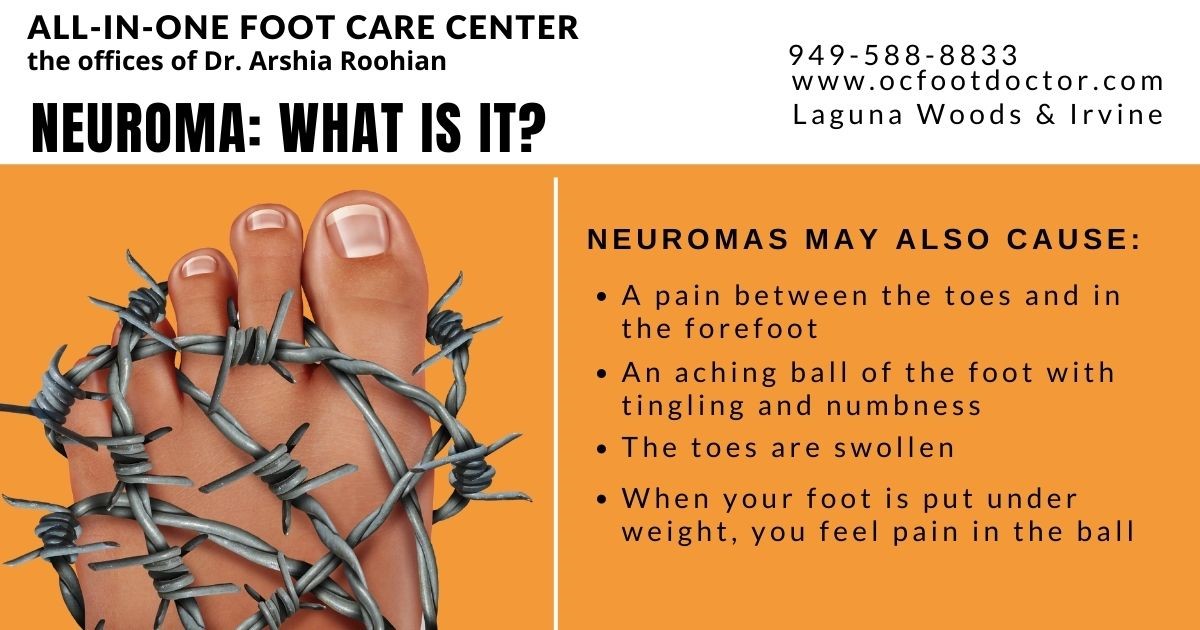Neuroma: What is it?

In what way is a neuroma different from a tumor?
In addition to being known as “pinched nerves” or “neuroma” or “nerve tumors”, neuromas are often found between the third and fourth toes as benign growths of nerve tissue. Toes and the ball of the foot are affected by this condition, which causes pain, burning sensations, tingling, or numbness.
Those suffering from neuromas often experience pain between their toes while walking. They often find relief by stopping their walk, taking off their shoes, and rubbing the affected area to alleviate the pain. Neuromas are often described as similar to having a stone in the shoe by patients. The majority of neuromas are found in women.
Factors contributing to
It is unclear what causes neuromas, but there are several factors that may contribute to their development:
- Deficiencies in biomechanics can lead to neuromas, since they increase the likelihood of instability around the toe joints around the foot.
- Inflammation or swelling of the nerve can result from nerve damage caused by trauma.
- A shoe of higher than two inches in height can increase pressure on the forefoot area if it squeezes the toes together. Choose footwear that does not squeeze the toes together.
- Neuromas can be caused or aggravated by repeated stress, a characteristic of many occupations.
Asymptomatic
In addition to the following symptoms, neuromas may also cause:
- A pain between the toes and in the forefoot
- An aching ball of the foot with tingling and numbness
- The toes are swollen
- When your foot is put under weight, you feel pain in the ball
Therapy at home
Could you please tell me what you can do to alleviate your discomfort?
- Make sure shoes have plenty of room for toes to move, low heels, and buckles or laces that can be adjusted to fit your feet.
- Shoe soles should be thick and shock-absorbing, and insoles should be designed to relieve excessive pressure.
- In order to prevent undue strain on the forefoot, high-heeled shoes should not exceed two inches in height.
- Using an ice pack can help dull the pain and improve comfort while you rest the foot and massage the affected area.
- You can reduce pressure around the affected area by using over-the-counter shoe pads.
Visiting a podiatrist when necessary
Symptoms of neuromas should be reported as soon as possible to a podiatrist. If left untreated, neuromas tend to worsen.
Symptoms and Treatments
Identifying the neuroma early in its development is critical to avoiding surgery to treat it. Treatment options vary depending on the severity of the neuroma.
Often, thick-soled shoes with a wide toe box can be adequate for reducing symptoms of simple, undeveloped neuromas, allowing the condition to subside naturally over time. It may, however, be necessary to perform additional surgery or treatment if the tumor is more severe.
Treatments for neuromas are typically designed to relieve pressure on the affected area. After finding the affected area, your podiatrist may take X-rays and suggest a plan tailored to your specific needs.
Injections: There is a possibility that special padding at the ball of the foot could correct the abnormal foot function and relieve symptoms caused by neuromas.
Treatment: The pain and inflammation caused by the neuroma can be eased with anti-inflammatory drugs and cortisone injections.
Insoles: In order to control foot function, one of your podiatrist's suggestions may be to make custom shoe inserts. Orthotics are sometimes helpful in reducing or preventing symptoms from worsening.
Podiatric Surgery: A podiatric surgeon may be required to treat the neuroma if early treatments fail and it progresses beyond the threshold for such options. After removing the enlarged and inflamed nerve, the procedure is usually performed as an outpatient procedure. After the procedure, you should expect a short recovery period. You will receive a detailed explanation of what will be done during surgery and what the results will be. Medications prescribed by your podiatrist can easily manage any pain following surgery.
Preventative measures
There are a number of preventive measures that can be taken to prevent neuromas, even if their exact origin is unknown:
- In order to avoid excessive compression of your toes, make sure the front part of your exercise shoes has sufficient room.
- The ball of the foot should be adequately padded in your shoes.
- Spend no more than two hours wearing shoes that have a narrow toe box or excessive heel height (greater than two inches).
You can contact our office at 949-588-8833, or visit our website at https://www.ocfootdoctor.com. Our offices are in Laguna Hills, Irvine, Mission Viejo, Aliso Viejo, Lake Forest, Foothill Ranch, and Costa Mesa.
📲 949-588-8833
🏢 24331 El Toro Rd, Suite 370 Laguna Woods CA 92637
🏢Irvine Medical Arts Building 113 Waterworks Way, Suite 250 Irvine, CA 92618
🌐 https://www.ocfootdoctor.com/
The information contained above is intended for general reference purposes only. It is not a substitute for professional medical advice or a medical exam. Always seek the advice of your physician or other qualified health professionals before starting any new treatment. Health information on this website MUST NOT be used to diagnose, treat, cure or prevent any disease without the supervision of your doctor.


